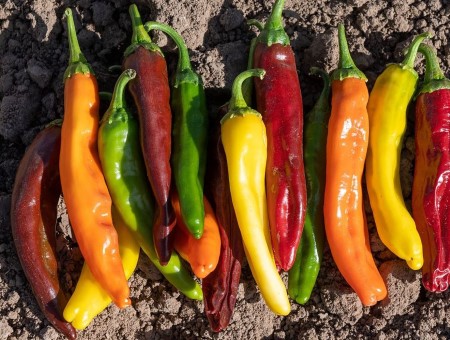
New Mexico State University’s Chile Pepper Institute to host annual New Mexico Chile Conference
Member News
The Texas Seed Trade Association Annual Membership & Policy Meeting Scheduled for February 11-13, 2024. Registration and Hotel Reservations are Live.
The room block is full. That does not necessarily mean we can't get you a room but you'll have to call Denise at 512-944-5052 and she'll do her best to accommodate you at our room rate. This is actually a good problem to have!
Senator Pete Flores will be with us on Monday as our special guest and speaker. Senator Flores has been a strong supporter of the Texas seed trade and will share his thoughts with us concerning Texas' future.
Dr. Paul De Laune, Texas AgriLife, will share his thoughts and research findings on applicability of cover crops in Texas agriculture. Cover crops are, finally, beginning to grab attention in Texas and may represent an opportunity for additional seed sales. How do they work in relatively dry agro-ecosystems? Come and listen to Dr. De Laune and bring your questions.
Katrina Horn will provide an overview of the Texas A&M AgriLife Research Crop Testing Program and its fit with seed companies.
Jeff Claxton from the Texas Department of Agriculture will lead a discussion on "variety not stated" small grain sales in Texas. TDA is a critical partner in combating VNS seed sales and we've got to find a way to all work together on this issue. Please come prepared to share your thoughts on this important topic.
Dr. Rick Vierling, Texas AgriLife Research, will provide an update on the Texas Foundation Seed Service facilities and programs. Rick plays a key role in our battle against VNS seed sales in Texas as well as administrate Foundation Seeds.
Jeb Owen, Texas Department of Agriculture, will provide an update on the certified seed winter growouts by location and share his thoughts on their future.
Pat Miller, American Seed Trade Association. will be with us to provide an update on ASTA activities, what's going on in other states that may find its way to Texas and the ongoing regulatory struggles with treated seed.
Monday morning will begin with our brief annual association business meeting chaired by TSTA President Chad Kriegshauser. We need to elect Board Members and Officers, we'll have a snapshot of how the state of the association is doing, priorities for this year and beyond. Our new President of the association will outline his/her vision for the upcoming year and how you can help make it happen.
Senator Flores will address us as his schedule allows. We have tentatively scheduled the Senator for just before lunch and are planning on him having lunch with us. We may have a technical/informational presentation before lunch but it's likely most of our invited speakers will present following lunch.
Registration is open and can be completed using this link.
The TSTA Board of Directors will meet on Tuesday February 13, in the morning.
Don't forget to bring an auction item for the scholarship fundraiser at the President's Reception & Dinner Monday evening.
Does anyone have a copy of "The Map?"
There have been recent requests for a copy of "the map" that was used to delineate the boundaries and plat of where TSTA members were planning to planting seed fields. The map was a detailed description of the High Plains showing individual fields and field boundaries and was essentially filled in annually at an event in Lubbock or Amarillo.
Apparently the practice stopped several years ago and the map hasn't been seen since. Any ideas where it might be would be appreciated. Please contact the TSTA office via reply email to this Weekly Update with clues.
Ah, c'mon; somebody must know where there's a copy of this.
2024 Texas Elections
TSTA Staff
Texas primary races for state house seats are in full campaign mode as early voting begins February 20th. Discussion we've had with incumbents is consistently indicating there are two issues driving well-funded opponents seeking to unseat them. The House of Representatives’ effort to impeach State Attorney General Ken Paxton last fall has led to a number of incumbents Texas House members being challenged in the primary when they otherwise may have had no primary challenger.
A few deep pocket contributors are funding the “Ken Paxton Retribution Tour” (an unofficial name we've heard quite often) which has forced an increase in campaign spending mainly through mail and media advertising.
The other issue drawing ire is the house vote on school vouchers. Twenty-one house members voted against allowing students to transfer to nonpublic schools and take some of their family's tax dollars with them to pay for the transfer. Sixteen of them are running for reelection and some face significant opposition, and may lose their race, over this issue. There seems to be a fairly discernible distinction on support for school vouchers based on urban versus rural school districts. Urban school teachers are more active in opposition to vouchers and rural school districts are seen as less likely to be significantly impacted by vouchers.
As is common nationally, misinformation is being spread around the Lone Star State. Win at all costs is a philosophy that a number of our representatives are unhappy to see even among challengers in the Republican primary.
Please plan to vote in your local elections this spring - and fall. We still maintain your local public policy-makers are more influential in your day-to-day life than those you send to Austin or Washington.
US OECD Seed Schemes Program – 2024 Assessment Fees
Implementation of the Organization for Economic Cooperation and Development (OECD) Seed Schemes in the United States is administered by the U.S. Department of Agriculture’s Agricultural Marketing Service (USDA AMS). Under USDA AMS, the Seed Regulatory & Testing Division (SRTD) serves as the National Designated Authority (NDA) for the program, which helps U.S. seed producers export seed to many international destinations.
Administration of the U.S. OECD Seed Schemes program is funded by assessment fees, which SRTD collects quarterly from State Seed Certifying Agencies (SCAs). Assessment fees are necessary to cover program costs because the program is not funded by Congress through the federal budget. USDA bases the fees on the quantity of seed certified under the program, and SCAs charge seed companies accordingly and collect the fee alongside the other charges associated with inspections and testing.
Current assessment fee rates are 33 cents per hundredweight (cwt) for corn and 22 cents per hundredweight for all other crop species, which will remain through June 30, 2024.
Due to rising costs associated with implementing the program, it is necessary to implement a larger increase in assessment fees for 2024. The new fee structure is intended to better reflect relative value of species certified through the scheme as well as the volumes of seed of various species certified under the US OECD Seed Schemes program.
Effective July 1, 2024, assessment fees will be structured as follows:
 |
SRTD will continue to monitor program costs to effectively manage the OECD Seed Schemes program on behalf of the U.S. seed industry. Questions regarding the new fee schedule, or program policies and procedures, may be addressed to the program manager, Dr. Steve Malone at stephen.malone@usda.gov or by phone at 980-308-4617 (mobile) or 704-810-8888.
Information on the United States’ OECD Seed Schemes program can be found at: https://www.ams.usda.gov/rules-regulations/fsa/oecd-schemes.
German Farmers Finding a Sorghum/Corn Combination Planting Beneficial for Dairy Feed
from DSV
Due to the obligation of a resting crop on sandy and loess soil, a mixing cultivation of sorghum and corn is increasingly coming to the attention of growers. The combination of these crops offers opportunities for dairy farmers.
Rested crop
Since 2023, the growth of a rest crop has been a subject that farmers and arable farmers are busy with. On the one hand, there is the CAP in which the rest crop is an option to give substance to the eco-regulation. On the other hand, sand and loesssgrounds are obliged to carry a rest crop in crop rotation. Sorghum can be used as a resting crop.
For the mandatory resting crop on sand and loess soil, a mixing cultivation of sorghum and corn may also be used. However, the condition is that at least two-thirds of sorghum must be present on the country. This offers, for example, opportunities on plots that are further from home where corn is normally grown.
A mixing cultivation of sorghum and corn is not available for the eco-activities within the CAP. For this, the mixture must consist entirely of permitted resting crops. For the current laws and regulations, always consult www.rvo.nl.
Yield and feed value
A mixing of sorghum and corn ensures high yield, a lot of starch and good drought tolerance. The crops are similar in several ways. Sorghum has a slower initial development than corn. But the plants grow longer and experience no competition from the corn, so both crops are fully developed during harvest.
Tasting and practice plots show that the dry matter yield of this mixing cultivation is very good.
Because the sorghum type used has a somewhat lower starch content compared to maize, the starch yield is slightly lower than maize in monoculture. But on the other hand, the protein content is a bit higher, the resting crop obligation is met and there is qualitative and structural roughage in the pit.

Cultivation management services
A mixing cultivation always requires an adapted cultivation management. This also applies, for example, to grass clover in the field of fertilization and crop protection. However, the cultivation does not differ much from corn, but it must be taken into account.
Because the sorghum seeds in the Sorghum-Mais Mix are pilled, the mixture can easily be sown with a corn seed machine. In addition, the crop can easily be harvested with a maisha petr.
Pay particular attention when choosing the right sowing moment, fertilization and crop protection.
More information about the cultivation of Sorghum-Mais Mix can be found in our cultivation manual or in the DSV forage brochure 2024 which you can download from here.
FARMERS' PROTEST AGAINST INCREASING GOVERNMENT REGULATIONS SPREADING THROUGHOUT EUROPE
by Ryan Hanrahan, farm policy news editor and social media director for University of Illinois' farmdoc project
Editor's Note: This is a follow-up to last weeks article on German farmers protesting the loss of their diesel fuel subsidy, and on a larger scale, their loss of any ability to make a profit. North American farmers face many of the same challenges as their European brethren - namely over-regulation. As some significant amount of seed is moved to Europe from Texas we should be aware of our end-users circumstances.
Just a few weeks after farmer protests against government regulations and taxes began in Germany, protests are now "spreading across Europe, with workers from countries including France and Poland disrupting transport routes over rising costs and burdensome regulations," Bloomberg's William Horobin and Milda Seputyte reported.
The protestors also made their way to the European Union headquarters in Brussels on Wednesday, "where farmers decried everything from petty bureaucratic meddling to the scourge of bankruptcy and worse," the Associated Press' Sylvie Corbet and Raf Casert reported.
In response, "European Commission President Ursula von der Leyen said Thursday that it's time to address the growing divisions over agriculture as she tried to respond to burgeoning protests from farmers over green policies and subsidy cuts in a crucial election year for Europe," according to reporting from Bloomberg's Lyubov Pronina, Jorge Valero, and Valentine Baldassari.
Protests in France
The bulk of the new protests this week are taking place across France, where "protesting farmers blocked roads across France on Wednesday to press the government to ease its drive for lower consumer prices and loosen environmental regulations," Reuters reporters Nacho Doce and Kate Abnett reported.
"Many farmers struggle financially and say their livelihoods are threatened as food retailers are increasing pressure to bring down prices after a period of high inflation," Doce and Abnett wrote. "'There are too many regulations,' Thomas Bonnet, the head of a youth farmers' union in southwestern France's Castelnaudary area, told Reuters at a blockade."
While the blockade has so far not spread into Paris, "Arnaud Rousseau, head of the powerful FNSEA farming union, told France 2 TV he could not rule out that protests could disrupt the Paris region," Reuters reported.
The protests in France have already had deadly implications, as the BBC's Chris Bockman and Paul Kirby reported that on Tuesday, "a French farmer in her thirties and her 12-year-old daughter have died after a car crashed into a roadblock during a nationwide protest by French farmers. The accident, which left the farmer's husband badly injured, happened an hour south of Toulouse as the protest grew."
Protests in Poland and Lithuania
In Poland on Wednesday, "disgruntled farmers slow-drove their tractors through major cities in protest at what they call "unfair" competition from neighboring Ukraine, which has been granted special wartime export regulations," Corbet and Casert reported.
"More than 1,000 farmers with tractors also began a protest in the center of Vilnius, in Lithuania, and pledged to continue the demonstration until Friday," Horobin and Seputyte wrote.
Protests in Belgium
"Around 200 farmers gathered in central Brussels on Wednesday, saying they can no longer cope with EU regulations and tumbling earnings, according to Le Soit newspaper," Horobin and Seputyte reported.
"Smaller family farmers are behind many of the protests across the bloc," Corbet and Casert wrote. "They complain that applying nitpicking EU regulations not only force them to spend hours on their laptops instead of their tractors, but also require major investments that starts bleeding red on their books. The EU and governments insist that a warming climate and agricultural pollution forces them to push through drastic measures. Those measures are now raising anger."
And "with the political visibility of farming and food going to the heart and origins of the EU, the volatile sector could turn into a burning issue before the June 6-9 European Parliament election, pitting traditional political groups on the defensive against populist and far-right parties sensing an opportunity," Corbet and Casert reported.

French farmers block roads, bridges as protests sweep country
Factoids
New Mexico State University’s Chile Pepper Institute to host annual New Mexico Chile Conference
NMSU release

For the 42nd year, New Mexico State University’s Extension Plant Sciences Department and the Chile Pepper Institute is set to host its annual New Mexico Chile Conference.
The conference will take place Feb. 5 and 6 at the Las Cruces Convention Center. A welcome reception will kick off the event from 4 to 6 p.m. Monday, Feb. 5, with keynote speaker Rich Pratt, director of semi-arid cropping research innovation program at NMSU. Pratt will present “From Mild to Wild and Back Again: Genetic Diversity, Crop Improvement Strategies, and our Shared Cultural Heritage with Chile.” Registration will continue the following day at 7:30 a.m., with morning and afternoon sessions planned.
“In support of the state’s iconic crop, the New Mexico Chile Conference is held to provide the latest chile pepper research and information,” said Stephanie Walker, extension vegetable specialist at NMSU. “It is an immersive experience that provides useful knowledge for all in attendance, from chile pepper enthusiasts to industry professionals.”
Topics and speakers include:
- John Stommel, research geneticist with United States Department of Agriculture, who will present “Capsicum: A Colorful Crop with Versatile Opportunities”
- Frannie Miller, assistant professor in NMSU’s department of Agricultural Economics and Agricultural Business, who will present “Supporting the Specialty Crop Industry – An overview of Farm Bill policies and a preview of a specialty crop management tool for New Mexico”
- Steve Hanson, associate professor in NMSU’s department of Entomology, Plant Pathology, and Weed Science, who will present “Evaluation of Sustainable Methods for Disease Control in Chile”
- Joanie King, assistant professor in NMSU’s Extension Plant Services, who will present “Pepper Weevils” The event provides an opportunity to bring chile industry professionals together and showcase their products and solutions to growers, researchers, processors, and other industry professionals.
NMSU’s Extension Plant Sciences Department and Agriculture Experiment Stations will also host an agrivoltaics-focused community meeting from 10:30 a.m. to 12:30 p.m. Wednesday, Feb. 7, at the USDA ARS Southwestern Cotton Ginning Research Laboratory, located at 300 College Ave.
The meeting, “Discover the Future of Agrivoltaics in New Mexico,” will provide valuable insight from both local and national experts on agrivoltaics, the simultaneous use of land for both solar panels and agriculture, and its potential integration within our community.
For more information about registration or sponsorship opportunities, visit https://cpi.nmsu.edu/programs/nmcc.html. You can also contact the Chile Pepper Institute at 575-646-3028 or .
ENDANGERED SPECIES ACT IMPLEMENTATION WILL FINANCIALLY IMPACT EVERY FARMER
By Aaron Putze, Chief Officer of Strategy and Brand Management for the Iowa Soybean Association
*Environmental Protection Agency (EPA) commits to fully implementing federally mandated Endangered Species Act (ESA).
*Act requires all federal agencies to ensure their actions don't harm nearly 1,700 listed endangered or threatened species (80 more are under consideration, including the Monarch butterfly).
*"Actions" include EPA's registering pesticides under the Federal Insecticide, Fungicide and Rodenticide Act (FIFRA).
Soybean leaders closely monitoring EPA's actions pertaining to the ESA and FIFRA as its provisions currently implicate the crop protection products used by U.S. farmers on every acre planted to soybeans.
The Environmental Protection Agency's latest attempts to implement the federally mandated Endangered Species Act (ESA) are raising major concerns - and headaches - among farmers and ag retailers.
Just ask Ashlea Frank, a Federal Insecticide Fungicide and Rodenticide Act (FIFRA) expert.
"I live and breathe it," says Frank. "Perhaps that's why I sometimes can't fall asleep and when I do, feel I'm awakening from what seems like a nightmare."
Her perspective is molded by an acute understanding of nearly every nuance of FIFRA and the impact of its implementation on farmers' access to products critical to staving off insects and disease. It's also impacted by her passion for agriculture and a family history of farming in the hill country of central Texas.
"This stuff is brutally complicated. It's also deeply personal," she says.
ESA's origins
Frank represents the 16 participants involved in FIFRA's Endangered Species Task Force. It was created in 1994 to ensure EPA fulfills a federal mandate to track endangered species locations and where pesticide applications occur.
The task force's jurisdiction has expanded to support current agency assessments, species protection goals and implementation by end users of crop and livestock protection products.
One must first understand the history of the ESA and FIFRA to truly understand its potential implications on the ability of farmers to grow soybeans profitably.
The EPA was founded in 1970. Three years later, Congress established the ESA to protect critical species and their habitats. The work is conducted within the U.S. Department of Interior via the U.S. Fish and Wildlife Service and U.S. National Oceanic and Atmospheric Administration's National Marine Fisheries Service.
The ESA requires all federal agencies to ensure their actions do not harm the nearly 1,700 listed endangered or threatened species (80 more are under consideration, including the Monarch butterfly). "Actions" include the EPA's registering pesticides under FIFRA.
To read the entire article click here.
ETHANOL MARKET FORECAST TO GROW 63% TO $153 BILLION IN 10 YEARS
Source: DataHorizzon Research news release
Fort Collins, Colorado -- The Ethanol Market size was valued at USD 94.2 Billion in 2022 and is anticipated to reach USD 153.5 Billion by 2032 with a CAGR of 5.1%.
Ethanol is a versatile biofuel that has emerged as a crucial factor for transitioning to a sustainable and eco-friendly future. In addition, the growing awareness of the environmental hazards caused by burning fossil fuels has prompted a shift in perspective towards cleaner alternatives.
Key drivers shaping the market growth:
1. Emphasis on Clean Environment: The ethanol market growth is anticipated to be positive in the forthcoming years owing to the rise in demand to reduce carbon emissions and footprints. The growing pressure to curb climate change at international levels and the sustainability need for the future has triggered the demand for ethanol.
2. Technological Advancements: While the global petroleum and fuel industry emphasizes a clean environment, various initiatives are pursued to reduce carbon emissions and greenhouse gases and achieve higher decarbonization levels. Besides, the ongoing research and development have resulted in technological breakthroughs. For instance, cellulosic ethanol production is estimated to augment the sustainability and efficiency of overall ethanol production processes.
3. Government Policies: Worldwide, governments are transitioning to clean energy sources and alternatives owing to increased awareness and international pressures. For instance, the Indonesian government has devised plans to roll out 5% to 15% ethanol and 80% or higher percent gasoline blends for fuel usage in the coming years. In 2024, the Government of Brazil technologically collaborated with India to facilitate 20% ethanol blending for petrol by 2026. India will also receive indigenous breeds from Brazil to enhance livestock productivity and boost the poultry sector. Globally, Brazil is the second-largest producer of Ethanol.
Future Outlook:
The future outlook of the ethanol market is positive, with anticipation of several trends for the foreseeable future.
1. Emergence of Biorefineries: Biorefineries will dominate in the near future based on their technological integration with traditional sources to produce biofuels. These facilities maximize the use of biomass resources, contributing to resilience and more stability to the economy.
2. Emerging Markets: Developing economies largely focus on economic growth and sustainability. Ethanol is industrially perceived as a catalyst to reduce greenhouse gas emissions for various sectors. Therefore, fuel-based sectors are more likely to adopt fuel alternatives that reduce their CAPEX and OPEX to add constancy to the production processes.
3. Global Collaborations: The government's role and policies is crucial in shaping market growth in the future. With an ecosystem of industries, governments, and research institutions, collaborations amongst these entities will shape new avenues for exchanging knowledge, technology, and best industry practices.
For more information on this report click here.
About DataHorizzon Research:
DataHorizzon is a market research and advisory company that assists organizations across the globe in formulating growth strategies for changing business dynamics. Its offerings include consulting services across enterprises and business insights to make actionable decisions. DHR's comprehensive research methodology for predicting long-term and sustainable trends in the market facilitates complex decisions for organizations.
Editor's Note: Are you buying this? Seems to concentrate on cellulosic and, so far, that hasn't actually done so well. We certainly prefer alternative fuels to electric vehicles and it would be good for our business, but we'd like to know what you think. Is ethanol production set to increase dramatically?
News Bits
The Guardian
The EU must "reject the darkness of anti-science fearmongering" before a key vote on gene editing, 34 Nobel prize winners have said.
In an open letter shared with the Guardian and other European newspapers, the laureates demanded that lawmakers relax strict rules on genetic modification to embrace new techniques that target specific genes and edit their code. The technology could make crops more resistant to disease and more likely to survive extreme weather events that are growing more violent as the planet heats up.
The scientists said old methods of breeding crops over years and decades was taking too long. "We do not have this time in an era of climate emergency," they wrote.
The letter sent to MEPs on Friday was organised by WePlanet, an environmental nonprofit that campaigns for technologies like nuclear power, gene editing and cellular agriculture, as well as rewilding most of Europe. The more than 1,000 signatories to the letter range from leading biologists and geneticists - including the scientists who won a Nobel prize for discovering the Crispr "genetic scissors" at the heart of the debate - to celebrity authors such as the psychologist Steven Pinker and philosopher Peter Singer.
Supporters say the new rules could help farmers use fewer pesticides and less fertiliser. Some plants that are hard to breed by conventional means - such as fruit trees, grape vines and potatoes - use some of the most harmful pesticides in the EU, the scientists said.
For the most part, environmental groups have fiercely opposed efforts to change the genetic code of plants and other organisms, voicing fears about their safety and the danger of changes with unintended consequences. Proponents of the technologies, particularly highly targeted ones, have argued that such risks pale in comparison to the known dangers of biodiversity loss, the climate crisis and hunger. The European Food Safety Authority has found no new hazards from targeted gene editing in plants compared with conventional breeding.
To read entire report, Click Here
Placements of cattle into U.S. feedlots have declined for a second consecutive month.
The USDA says 1.704 million head of cattle entered feedlots in December 2023, down 4% from December 2022, implying tighter market ready supplies later this year. Most of those placements were cattle weighing less than 800 pounds.
Marketings during December fell 1% to 1.253 million head, while the total number of U.S. cattle on feed on January 1st was up 2% at 11.93 million head. That on feed total included 7.195 million steers and steer calves and 4.735 million heifers and heifer calves, both 2% above last year.
Source: IRS
The Internal Revenue Service has issued the 2024 optional standard mileage rates used to calculate the deductible costs of operating an automobile for business, charitable, medical or moving purposes.
Beginning on Jan. 1, 2024, the standard mileage rates for the use of a car (also vans, pickups or panel trucks) will be:
• 67 cents per mile driven for business use, up 1.5 cents from 2023.
• 21 cents per mile driven for medical or moving purposes for qualified active-duty members of the Armed Forces, a decrease of 1 cent from 2023.
• 14 cents per mile driven in service of charitable organizations; the rate is set by statute and remains unchanged from 2023.
These rates apply to electric and hybrid-electric automobiles as well as gasoline and diesel-powered vehicles.
The standard mileage rate for business use is based on an annual study of the fixed and variable costs of operating an automobile. The rate for medical and moving purposes is based on the variable costs. The charitable rate is set by law.








